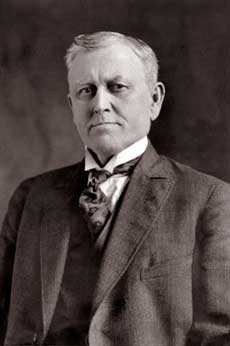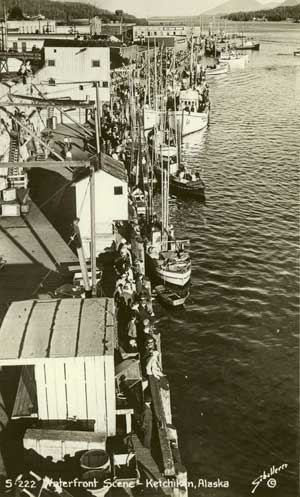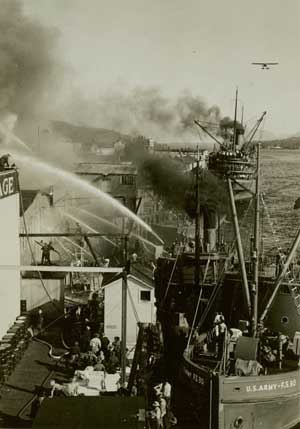 and colorful Mgr. Jim Pinkerton By June Allen December 09, 2003
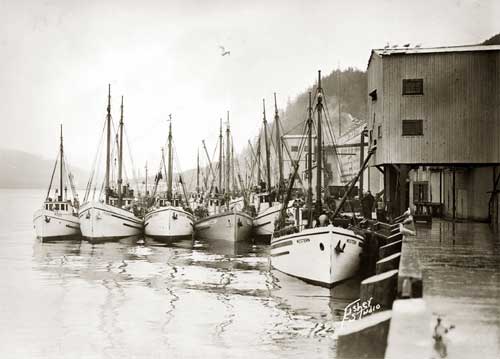 Donor: Ed Elliott, Courtesy Tongass Historical Society
In 1904, curious to know if there might be a commercial future for iced fish, Hunt made a test run, shipping halibut packed in ice to Seattle. Probably that shipment was encased in
The iced-fish shipping experiment was a tantalizing success. A small scale operation then was set in motion and conducted as well as it could with limited facilities. In time it caught the interest of a number of interested local investors, including such well known names as J.C. Barber of Citizens Light and Power (precursor of KPU);Willis A. Bryant of J.R. Heckman and Co.; bakeryman and future mayor Mike J. Heneghan, haberdasher and future hotelman and mayor P.J. Gilmore, and three doctors: Ben, John, and Alex Myers. Their enterprise would be a locally owned cold storage facility. and then came the fabled halibut Salmon was the king of fishes in those early years. But it was the possibility of including in their plans the marketing of the long neglected North Pacific halibut, the hot new entrant on the fishery industry scene, that made the investors more comfortable with the considerable gamble of building a costly refrigeration facility that was considered high-tech in its day. The Old World's Atlantic halibut - the word derived from "holy" and "butte" or flounder - had been all but fished out on the other side of the globe. For some reason, no one had thought of the commercial potential of the giant Pacific breed of the fish until 1888! The halibut is a curious fish that bottom feeds with its white side toward the ocean floor and its black side up. Young halibut have eyes on either side of the head like any other fish but as the young fish grows, both eyes move up to the black topside of the adult fish. Halibut can grow to eight feet in length and weigh up to 500 pounds! The record age for one of these fish is 55 years. These halibut of the Pacific - which range from as far south as central California and as far north as Nome - had long been a favorite in the diet of the Indians of the Pacific Coast, especially the Haidas. Those seafarers of the Queen Charlotte Islands lived close to the deep banks where the bottom feeders were easily found. Halibut even figured prominently in Haida legends; one of which claims the First Man emerged after the Flood from a halibut that had violently shaken off its head and tail. Another legend says that the Queen Charlottes were once just a single island that became broken apart from the thrashing tail of a giant halibut deep under the earth. 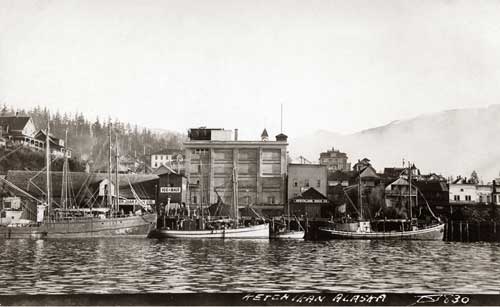 San Juan Fish Company, Ketchikan Cold Storage, Northland Dock Company and Halibut schooners Progress and Venus Photographer: David Nicoll Donor: Irene McGillvray, Courtesy Tongass Historical Society
KCS was a thriving business through the Roaring '20s, the Alaska fisheries heyday. In 1921 an addition was built to the first concrete section of the KCS building. The expansion program included a 30-ton ice tank, a huge ice storage room and two additional flash storage rooms. A new engine room was added with a new 100-ton refrigeration machine. The shipment of iced fish to the East by way of Prince Rupert's railhead began experimentally in 1923 and later grew to large volume. Ketchikan was not only a port of call for the halibut skippers but home port for many of them. By 1926 Ketchikan's halibut landings reached more than eight million pounds, doubling the landings of the previous year. Times were good! 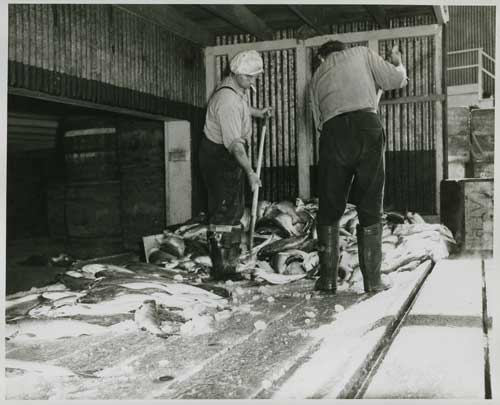 U.S. Fish and Wild Life Service Photos Donor: Phil Dorhrerty, Courtesy Ketchikan Museums
In 1936 Citizens Utilities of Minneapolis took over the economically staggering Ketchikan Cold Storage Co. And during the slow Depression years Ketchikan Cold Storage limped along. Then came the economic flurry of the World War II years and, shortly after, the arrival in Ketchikan of KCS's new manager-to-be. and then came Jim Pinkerton Not everyone in Ketchikan would come to think of Jim Pinkerton as a great guy, but someone did! One was Jane Church's father, Jack Talbot. It was 1946 and Pinkerton had booked passage from Vancouver to Ketchikan on the SS Prince Rupert, traveling in his
When Talbot's crisis was past, Pinkerton was introduced to Ketchikan Cold Storage Manager Jack Mendenhall, who hired him as his assistant. Two years later Pinkerton was named manager and was in charge. Within a decade the new manager had the cold storage on its feet and restored to its former position as a leader in the industry. He established a buying and processing service for the benefit of dealers throughout the United Sates. The service enabled dealers to buy their halibut, salmon and sablefish requirements direct from the fishing fleet and to eliminate all middlemen. Through Pinkerton, dealers from Fairbanks to Miami, and from Boston to San Diego as well as points in between bought their requirements from the fishing fleet at Ketchikan, according to a 1959 newspaper clipping. In addition, Pinkerton's policy enabled Ketchikan Cold Storage to process more than five million pounds of halibut, salmon and sablefish during the 1959 season alone. But the fading of the fishery told him that the end could be in sight. Pinkerton's approach to the problems he saw in the cold storage management at the highest levels echo Ketchikan's present overall economic problems, as expressed in a letter. Pinkerton was a man who didn't mince words. In a memo to a high KCS official in New York in 1954 he wrote: "This plant is located on an island in Alaska not at the corner of 42nd and Broadway. Take a good long look at your big empty plant up here in this God-forsaken part of the world and realize that business is not going to come looking for you! We've got to go looking for business You've either got to go whole hog or write this property off." When Statehood allowed the new state's own on-site management of fisheries, steps were taken to save and hopefully restore the fisheries viability. Fishing seasons were shortened and some areas closed, with whole new management policies in place. It would take time to repair the damages of half a century of long-distance fishery management by the federal government. Resources were thin, prices falling. A Jan. 12, 1960, a fire of an unknown origin in the old Hunt Building, destroyed the two top floors of the structure but adjacent buildings were saved. Then just two weeks later, a suspected arson fire on Jan. 26, 1960, destroyed a large section of Front Street, burning the businesses but sparing the Ketchikan Cold Storage site. Gone were Colin Poole's shoe store and Bertha Wells's book store. KCS's main structures were saved but its smaller warehouses and outbuildings were destroyed. In July of 1968 one of the last of the KCS artifacts burned, its large frame building on Water Street. Then all that was left was the hulking concrete structure. The wrecking ball made short work of that just a month later to make way for the state's widening of Front Street. Both Front Street and Water Street were widened although it seems hard to believe today that either street was ever narrower than it is now. Jim Pinkerton moved back to his company's
Hard work equaled success to Jim Pinkerton. He was a good-sized man with an Alabama drawl that he never lost and didn't want to lose. He liked good food, nice homes, glamorous women and small dogs. As mayor he set a good example: Every day he walked his dog and carried tissues and little bags for properly disposing of the dog's droppings. But although a friendly and talkative man, it wasn't until shortly before his death in 1996 at age 80 that he was willing to tell the story of his early life a hard life. He was born March 30, 1916, in Georgiana, Alabama, son of sharecroppers who had a large family of children including adult siblings. At age 5, Jim lost his mother, who was committed to the Insane Asylum at Tuscaloosa where she later died. Soon after, his father, characterized by Jim as "the convict," began to serve "every day of a ten-year sentence for arson." Then when he was about 12, he found himself chopping out the roots of Johnson grass with a hoe on a hot afternoon in a puny Alabama cornfield. Jim wrote, "I thought, this ain't for me! God, do help me get away from here!" He had prayed, his very first prayer. His older sister Bessie took him to Florida with her and put him in school. But then a hurricane ravaged that state and his sister's home was destroyed. In despair, Bessie committed suicide and Jim was alone. By then Jim was a teenager and like many boys in the depths of the Depression, he struck out on his own, working but still going to school. At age 19 he graduated from high school in Palm Beach. He managed to get two years of junior college completed when World War II broke out in 1941, when he joined the Maritime Service. In Ketchikan all these years
later, no one who knew KCS Manager and Mayor Jim Pinkerton ever
forgot him. He was, somehow, bigger than life. You know how many
elderly folks worry about suffering a heart attack in the privacy
and of their homes? And pray that someone will come to help them?
well, an elderly Jim Pinkerton had a serious heart attack on
the Great Wall of China, accompanied by a flurry of assistance
from fellow tourists and a number of news reports! That was just
Jim. He died several years later in Redding, Calif., in August
1996. He is missed, as is Ketchikan Cold Storage.
june@sitnews.org
All rights reserved. Not to be reprinted in any form without the written permission of June Allen.
|
||||||||||
